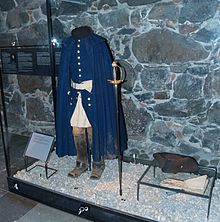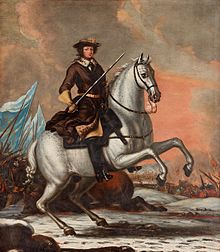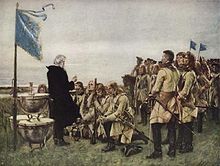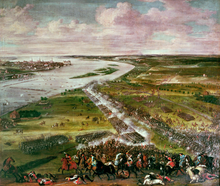Caroleans


Caroleans (Swedish: karoliner) were soldiers of the Swedish kings Charles XI and Charles XII. In the late 17th and early 18th centuries, in order to compensate for its lack of manpower and resources, Sweden strove for innovative ways to make a more effective army. The tactics of Caroleans differed from those of Western European soldiers in their greater reliance upon pikes, rapiers, bayonets, and offensive strategy, which helped them to be victorious, even when greatly outnumbered, in many important Swedish battles. The Carolean army is regarded as one of the most effective military forces of their time.[citation needed]
The Carolean army was always relatively small. As a result, heavy losses were irreparable, which forced commanders to choose their battles wisely and strategize carefully to keep casualties low. Despite the Carolean army's effectiveness, its small size prevented Sweden from maintaining its hold on power, as evidenced by the decline of the Swedish Empire after its defeat in the Great Northern War. After a long march into the Russian interior—where the Carolean army was exposed to scorched earth tactics and frequent small raids—the exhausted and hungry Caroleans were decisively defeated by the Russians at the Battle of Poltava. During that campaign, an estimated 35,000 Swedish troops died—70 percent of the entire Carolean army—25,000 in combat, with another 10,000 dying from famine, disease, and exhaustion.
Overall, 350,000 soldiers from Sweden, Finland, and the Baltic provinces died in the service of Charles XII during the Great Northern War, mostly from non-combat causes. Two-thirds of these, or over 230,000, died in the years 1700 to 1709. These losses constituted an unusually large percentage of the pre-war population of 2.5 million. The losses of their enemies (Russia, Poland-Lithuania, Denmark-Norway, and various northern German states) are incalculable, but known to be far higher.[1]
Allotment system[]

In 1680, King Charles XI and parliament implemented many political and military reforms that amounted to making the king an autocrat. The most significant reform was the establishment of the allotment system. Under this new system, Swedish farmers were to provide the crown with regiments of 1,000 or 1,200 men, complete with weapons and uniforms. Either independently or as rotes (groups) of no more than five, farmers would contract with the crown, with each rote providing and supporting one soldier, including giving the soldier a cottage and a garden plot.[2] Each cavalryman was additionally provided with a horse. In exchange for these burdensome policies, each rote was granted a reduction in taxes.[3]
The allotment system provided Charles XI with a professional army of 18,000 infantrymen and 8,000 cavalrymen. The system also provided for the deployment of 6,600 seamen, bolstering Sweden's navy. Adding to Sweden's numbers, Finland provided an additional 7,000 infantrymen, 3,000 cavalrymen, and 600 seamen.[3]
Organisation[]

The Carolean army was organized into cavalry regiments, including the Jämtlands dragoon regiment; infantry regiments, including the Värmlands and Västerbottens regiments; and artillery regiments. Most regiments were recruited from the same region.
The (Royal Life Guard Corps) was a special unit made up of approximately 100 men under the personal command of King Charles XII, of which he was captain. To become a private in the corps, one had to attain the rank of captain in the regular army. The corps second in command was a colonel with the title of Kaptenlöjtnant (Lieutenant-Captain). This corps fought to the bitter end, and some of its veterans carried Charles XII's coffin to Stockholm for burial in 1719.
Uniforms[]
Carolean soldiers wore the Swedish Standard Uniform introduced by Charles XI—which featured blue great coats with yellow cuffs, white breeches, and yellow vests—with many regiments wearing variants thereof. For example, the dragoons of Bohuslän had green coats, and the regiment of Närke-Värmland had red cuffs. The artillery had grey coats with blue cuffs. As headgear, most Caroleans wore tricorne hats or a special cap called a . Members of the elite Drabant Garde cavalry—the only armored troops—wore steel breastplates.
Weaponry[]
Most of the infantry were musketeers equipped with modern flintlock muskets—with bags for ammunition—although older versions were still in use, as well as rapiers. About one-third of each company were equipped with pikes. Twelve men of each company—typically the strongest and tallest—were grenadiers, who were the only soldiers to have bayonets affixed to their muskets, as regular musketeers were meant to use their rapiers for hand-to-hand combat. Grenadiers were often placed on the flanks of a unit to protect against cavalry. A bayonet-equipped musket was considered to be more practical for that, as it gave greater reach than a sword when facing a mounted opponent and could be braced against the impact of a charge. Sweden standardized bayonets for all soldiers by 1704, though they also still carried swords.[4] On occasion, two-handed spiked clubs were used during sieges. Mounted troops carried broadswords and either two pistols each for a regiment of horse, or a carbine each for the dragoons. The artillery had a smaller sword for close combat, called a hirschfängare.
Notably, the standard sword issued to the Swedish infantry was straight rather than curved (closer to a rapier than a saber), reinforcing the emphasis on stabbing rather than slashing.[5]
Rations[]
A soldier's daily ration was to consist of 625 grams (22.0 oz) of dry bread, 850 grams (30 oz) of butter or pork, 1⁄3 litre (0.59 imp pt; 0.70 US pt) of peas, and 2.5 litres (0.55 imp gal; 0.66 US gal) of beer. The butter or pork was often replaced by fish if the latter were available.[6] Water was generally avoided since it was often contaminated.
Discipline[]


Strict discipline was necessary for the Carolean army to be able to use its highly offensive tactics. Religion played a significant role in maintaining discipline and keeping morale high among the Caroleans.[citation needed] Priests preached with patriotic fervor the virtues of serving the crown and being a soldier, in an effort to boost enlistment.[citation needed] Priests often participated in battles to raise morale and preached that soldiers fought for the common beliefs of the Swedish Lutheran Church. This also reminded soldiers that they had God's protection and assistance in battle, a notion originating when Sweden fought in the Thirty Years War as the continental leader of Protestantism. After the Battle of Narva, many soldiers believed that God had sent the blizzard that led to their victory as a punishment for their enemies' sins and hubris.[citation needed] To boost morale, men from the same region or province of the kingdom were kept together and fought beside each other. The steadfast courage shown by the Caroleans adversely affected enemy morale and, on several occasions, frightened the enemy into retreating.[citation needed]
To achieve tactical superiority and in order not to waste ammunition, attacking soldiers exposed to medium-distance enemy fire had to resist responding until close to the enemy. The army had stringent rules to attain this discipline, many of which constrained a soldier's private life. For example, members of the Carolean army received constant supervision at their barracks[citation needed] as well as in the field. Stealing food from another soldier would lead to harsh punishment[clarification needed]. Looting, previously a part of the soldiers' everyday activities, was forbidden; however, it occasionally occurred.[citation needed] To take God's name in vain was among the worst crimes a Carolean soldier could commit,[citation needed] and the punishment for this was death, because it was vital to keep morale high among the troops, and the Christian religion was used as a way to do this. Interrupting a moment of prayer would also lead to the death penalty.
Soldiers were told not to be afraid of battle or to be fearful on the field; since if God meant for them to die, death would happen regardless of whether they dodged bullets or not. This rationale was crucial to the offensive tactics of the Carolean army, which required firm discipline to succeed.
Formations and tactics[]

A) company-wise B) battalion-wise.
A Carolean infantry regiment consisted of roughly 1,200 men, divided into two battalions of 600 men each. The battalion was the smallest tactical unit of the Swedish army and consisted of four companies of 150 men each. Prior to battle, the men were usually formed into four ranks (four men deep), however, a battalion could also be späckad (i.e. fattened) in six ranks.[7][8] About one-third of the men were pikemen, equipped with swords and 5.55-metre-long (18.2 ft) pikes. These pikemen often were in the middle of each battalion with musketeers on their flanks; however, if the battalion was späckad, the pikemen were placed in the third and fourth ranks. Grenadiers were often on the flanks of the musketeers—on the left and right of each battalion—to protect against enemy cavalry and to toss grenades to break enemy formations (there being one grenadier for ten musketeers).[9] On occasion, the grenadiers formed their own battalions, such as the Life Grenadier Regiment. The width of a battalion was roughly 180 metres (590 ft) (or 135 metres (443 ft) with the battalion in close formation). At the outbreak of the Great Northern War, every Swedish musketeer was equipped with a sword and usually a 20 millimetres (0.79 in) calibre flintlock musket without a bayonet; however, a bayonet was issued to every Swedish musketeer in 1704. The grenadiers were equipped with grenades, swords, and flintlock muskets with bayonets.[10]
A Swedish cavalry regiment consisted of roughly 800 men with 1000 horses among them, divided into four squadrons of 200 men each.[11] The squadron was the tactical unit of the cavalry and consisted of two companies of 100 men each. The Swedish heavy cavalryman was equipped with a rapier almost one metre long (primarily for thrusting and secondarily for slashing), a carbine, two pistols, and a cuirass.[12] Each dragoon was equipped with a rapier, musket (with bayonet), and two pistols.[13]
Certain irregular units were also used, frequently the Vlachs cavalry. However, these were not suited for combat, but only reconnaissance and to chase routed enemies.[14] Unlike other regular armies in Europe, the Swedish cavalry made up fully one-half of the fighting force.[15] During Charles XII's invasion of Russia, the army numbered 31,000 with more than half—16,800 men—being cavalry.[13]
Infantry Gå–På[]
Never have I seen such a combination of uncontrollable dash and
perfectly controlled discipline, such soldiers and such subjects
are not to be found the wide world over except in Sweden
General Stenbock, Gadebusch 1712[16]

The Gå–På (literally "Go-On") method was based on shock tactics and was the standard combat technique used in the Swedish army at the time. This very aggressive tactic often resulted in short-lived successful battles against superior numbers of the enemy.
According to army regulations of 1694 and 1701, the infantry attack operated as follows: In four ranks with gaps, a Swedish battalion would march "smoothly and slowly" towards the enemy lines, braving enemy fire that often started at a distance of approximately 100 metres. The Swedish soldiers were told not to fire until "you could see the whites in the enemies eyes", a range of roughly 50 metres. When the marching drums stopped the two rear ranks would fill the gaps within the two foremost ranks and fire a salvo, then draw their swords. The two rear ranks would then move back to their previous position, and the two foremost ranks would close the gaps in their lines, after which the battalion would resume their attack. The two foremost ranks would discharge their muskets in a final volley when they were within range to charge—a distance of roughly 20 metres. At these ranges, the powerful muskets usually felled many enemy troops, having a great physical and psychological impact on opponents.
Directly after the final volley, the Caroleans charged the enemy ranks with pikes, bayonets, and rapiers.[17] Note that the pikes were used as an offensive weapon; in close combat, they had the advantage over their foes' weapons due to their long reach. Often, complete ranks of enemies fled before physical contact was made, frightened by the long pikes and the fact that the Swedish battalions had previously calmly withstood their fire.[18]
Modifications during wartime[]
This method was slightly changed during the Great Northern War. The slow march was replaced by running, to take fewer casualties and begin combat sooner, while optimally still frightening the enemy with a swift, unflinching advance into their fire. The Swedish firing distance was reduced from 50 metres to 15–20 metres for the first volley of the rear ranks who would no longer fall into their previous position behind the front ranks. Instead, they would follow in the gaps within the front ranks. As a result, the battalion attacked in two closely formed ranks, which made the final charge more effective, as the Carolean troops would be closely packed together, making a heavier impact than before.
The battalion would also receive more support from artillery pieces, most notably in the battle of Gadebusch, where improved Swedish artillery pieces saw action.[19]
Analysis of method[]


As musketeers during this period usually fired by platoon, rank, or all together, it was eventually necessary for an entire group to stop and reload. During this reload—which took 1–2 minutes to finish—an opponent could calmly march 80 metres or run 150 metres (in one minute). This meant the first side to fire made themselves a vulnerable target to an oncoming enemy line. The Gå–På method took this into account.[20] The Caroleans would march calmly and steadily to close the gap during the enemy reload, before firing at a closer more effective range.
Cavalry Gå–På[]
The Swedish cavalry fought in a similarly aggressive way (also called the "Carolingian manner").[9] Prior to the battle, also in contrast to the rest of Europe—which at the time would form up "knee to the knee"—the Swedish cavalry would form up in a slight wedge formations in two or three ranks, "knee behind knee" to successfully achieve the most densely clustered cavalry formation possible to more fiercely impact the enemy line. They had thrusting rapiers which would further increase the effectiveness of the charge.[12] The squadron would usually not use their pistols during the charge, only blades. In 1704, a regulation was made that forbade using the pistol when charging (on occasion, the pistols were allowed, as happened in Fraustadt, or when chasing routed enemies). In 1705, another regulation decreed that the cavalry would ride at a trot during the initial phase of the attack and then at a full gallop just before reaching the enemy.[12][17] The trot conserved the energy of the horses for the final gallop, and only galloping the horses when within close range meant they wouldn't tire as quickly during the rest of the battle.
Coordination between units[]
Close coordination between infantry, cavalry, and sometimes artillery was needed to break down enemy defenses successfully. Only infantry would normally risk a frontal assault on a well-prepared enemy line, preferably with artillery assistance. Regimental cannons would keep pace with infantry and protect them against enemy attacks as they reloaded. The cavalry would strike the opposing cavalry or charge disorganized infantry, preferably in the flank or rear. Cavalry was also used to cover an army in retreat or to interfere with and chase remaining enemy after a successful infantry attack. If a cavalry attack were repulsed, it would fall back behind friendly infantry lines and regroup. If necessary, the infantry could fall back using alternating firing and movement. In some situations, infantry squares were used for protection against flanking cavalry attacks.[20] This formation was effective as all sides of the square would be facing outwards, removing the risk of a vulnerable rear or flank attack and the formation presented enemy horses with a tightly packed mass of troops and a veritable hedge of sharp weapons, discouraging them from a charge.
Battles[]
The Caroleans won several battles:
- Narva (1700) Defeated Russian army 3–4 times as large
- Düna (1701) Defeated Polish–Saxon army
- Klissow (1702) Defeated Polish-Saxon army twice their size
- Pultusk (1703) Defeated Saxon army
- Jakobstadt (1704) Defeated Lithuanian–Russian force
- Gemauerthof (1705) Defeated Russian army 2–3 times as large
- Warsaw (1705) Defeated Polish–Saxon force 4–5 times as large
- Fraustadt (1706) Defeated Polish–Saxon–Russian force twice as large
- Holowczyn (1708) Charles's favorite victory, defeating potentially numerically superior Russian force
- Helsingborg (1710) Defeated Danish invaders
- Gadebusch (1712) Sweden's final victory in the Great Northern War
See also[]
- Military of the Swedish Empire
- Swedish army
- Swedish allotment system
- Great Northern War
- Carolean Death March
Notes[]
- ^ Clodfelter, M. (2008). Warfare and Armed Conflicts: A Statistical Encyclopedia of Casualty and Other Figures, 1492–2015 (3rd ed.). McFarland. Page 94.
- ^ The Allotment Soldier and Root Farmer. Elfred Kumm 1949
- ^ Jump up to: a b Karoliner. Alf Åberg & Göte Göransson 1984
- ^ Gabriele Esposito. "Armies of the Great Northern War: 1700-1720." Osprey: 2019. Pages 10 and 16.
- ^ Mike Glaeser. "Swedish Gå På Tactics During The Great Northern War". March 14, 2018.
- ^ ; Göte Göransson (1976). Karoliner. Höganäs: Bra Böcker. pp. 26–27.
- ^ Konovaltjuk & Lyth, Pavel & Einar (2009). Vägen till Poltava. Slaget vid Lesnaja 1708. Svenskt Militärhistorisk Biblioteks Förlag. p 19.
- ^ Falk, Torp (1996). Etymologisk ordbog over det norske og danske sprog (4. opptrykk ed.). Oslo, Norway: Bjørn Ringstrøms antikvariat. pp. 799–800. ISBN 82-525-2548-2.
- ^ Jump up to: a b Lars-Eric Höglund, Åke Sallnäs, The Great Northern War 1700–1721 Colours and Uniforms. p 22.
- ^ Artéus, G Karolinska och Europeisk stridstaktik 1700–1712, P 29, 30. Exlibria, 1972
- ^ Brzezinski, Richard (31 October 2006). The Army of Gustavus Adolphus (2): Cavalry. Men-at-Arms. Osprey Publishing. p. 7. ISBN 978-185532350-6.
Officers were required to provide a different number of spare horses depending on their rank, but these were mostly riderless or in contemporary/jargon 'empty'. Thus a company of 125 'horses' numbered in reality about 100 troopers.
- ^ Jump up to: a b c Fraustadt 1706. Ett fält färgat rött, Sjöström, Oskar, 2008. p. 217, Historiska Media, Lund (Swedish)
- ^ Jump up to: a b Konovaltjuk & Lyth, Pavel & Einar (2009). Vägen till Poltava. Slaget vid Lesnaja 1708 (in Swedish). Svenskt Militärhistorisk Biblioteks Förlag. p 19.
- ^ Konovaltjuk & Lyth, Pavel & Einar (2009). Vägen till Poltava. Slaget vid Lesnaja 1708 (in Swedish). Svenskt Militärhistorisk Biblioteks Förlag. p 117.
- ^ Jump up to: a b Fraustadt 1706. Ett fält färgat rött, Sjöström, Oskar, 2008. p. 216, Historiska Media, Lund (Swedish)
- ^ Charles XII and the Collapse of the Swedish Empire, 1682- 1719 - R. Nisbet Bain. p. 243.
- ^ Jump up to: a b Olle Larsson, Stormaktens sista krig (2009) Lund, Historiska Media. p. 68. ISBN 978-91-85873-59-3
- ^ Fraustadt 1706. Ett fält färgat rött, Sjöström, Oskar, 2008. Historiska Media, Lund (Swedish)
- ^ Olle Larsson, Stormaktens sista krig (2009) Lund, Historiska Media. p. 250. ISBN 978-91-85873-59-3
- ^ Jump up to: a b Konovaltjuk & Lyth, Pavel & Einar (2009). Vägen till Poltava. Slaget vid Lesnaja 1708 (in Swedish). Svenskt Militärhistorisk Biblioteks Förlag. p 244.
- Caroleans
- Military history of Sweden
- 17th century in Sweden
- 18th century in Sweden
- 17th-century Swedish military personnel
- People of the Swedish Empire
